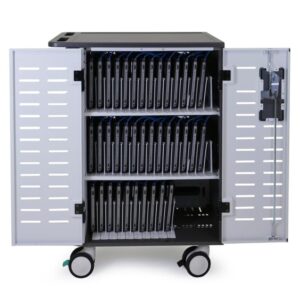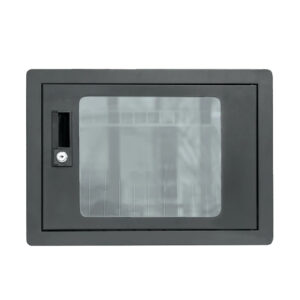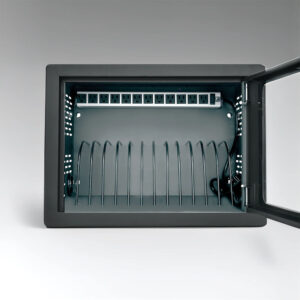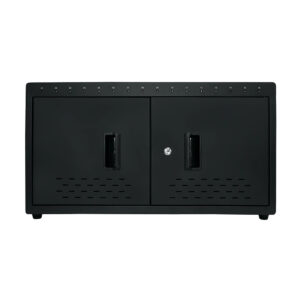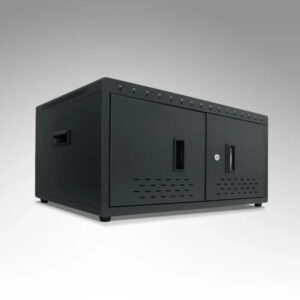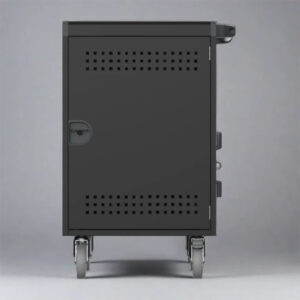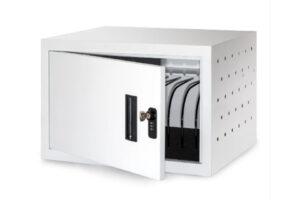Summary
Future-Proof Your Tech: Why a Universal Charging Cabinet is a Smarter Investment is a comprehensive examination of the increasing relevance and advantages of universal charging cabinets in today’s technology-driven environments, particularly in educational institutions and various industries. Universal charging cabinets, also known as charging stations or charging carts, serve as secure storage solutions designed to charge multiple electronic devices simultaneously, enhancing organization and accessibility while minimizing clutter from scattered chargers. As educational settings increasingly rely on electronic devices, the demand for efficient charging solutions continues to rise, making these cabinets a smart investment for future-proofing technological infrastructures.
These cabinets not only facilitate efficient device management but also offer eco-friendly features, such as smart charging technology that reduces energy waste. Their customizable and scalable options cater to diverse needs, ensuring that institutions can select models that align with their specific operational requirements. Enhanced security features, such as tamper-resistant locks and user-friendly interfaces, further enhance their appeal across various sectors, including healthcare and retail. Despite their advantages, challenges like high initial costs, infrastructure limitations, and interoperability issues persist, necessitating careful consideration before adoption.
Universal charging cabinets stand out from traditional charging methods by offering a centralized and organized approach to charging multiple devices, ultimately leading to improved maintenance and cost savings over time. Their energy-efficient capabilities contribute to sustainability initiatives, aligning with the growing emphasis on environmental responsibility within educational and corporate settings. By addressing the shortcomings of conventional charging solutions, these cabinets not only simplify device management but also promote eco-friendly practices, enhancing their long-term value.
In conclusion, the implementation of universal charging cabinets presents a compelling opportunity for institutions and organizations aiming to streamline their technology management while supporting sustainability goals. As the landscape of educational and corporate environments continues to evolve, investing in such innovative charging solutions positions organizations for future success and efficiency.
Table of Contents
Background
Charging cabinets, also referred to as charging stations or charging carts, are secure storage units designed to charge multiple electronic devices simultaneously. They are equipped with built-in power outlets, USB ports, and sometimes advanced features such as surge protection, cooling fans, and smart charging technology. These cabinets are particularly useful in educational institutions where numerous devices, including tablets, laptops, Chromebooks, and smartphones, are used daily.
The integration of charging cabinets facilitates efficient device management by eliminating the need for scattered chargers and power outlets. Instead, they provide a centralized location for storing and charging devices, enhancing organization and accessibility. Additionally, features like UVC lighting and internal cooling systems not only keep devices charged but also promote hygiene and prevent overheating, making them ideal for various industries beyond education, including healthcare, government, and retail.
Despite the many benefits, the implementation of charging cabinets also comes with challenges. Factors such as the initial cost of investment, the need for adequate electrical infrastructure, and potential interoperability issues with different device types can pose obstacles for institutions looking to adopt this technology. Nonetheless, as technology evolves and educational environments increasingly rely on electronic devices, the demand for efficient and effective charging solutions like charging cabinets is expected to grow, positioning them as a smart investment for future-proofing technological infrastructure.

Benefits of Universal Charging Cabinets
Universal charging cabinets offer a range of advantages that make them an essential investment for educational institutions and other settings that utilize multiple electronic devices.
Efficient Device Management
One of the primary benefits of universal charging cabinets is their capacity for efficient device management. By securely storing and charging multiple devices simultaneously, these cabinets help lower maintenance costs associated with wear and tear on devices. Proper charging and storage not only prolong the lifespan of electronics but also ensure that devices are always ready for use when needed.
Eco-Friendly Charging Solutions
Many modern universal charging cabinets are designed with energy-efficient features, such as smart charging technology that automatically stops charging once devices are fully powered. This capability minimizes energy waste and supports sustainability initiatives within educational institutions, contributing to a greener environment. Additionally, by integrating renewable energy sources, such as solar power, these cabinets can further reduce reliance on non-renewable energy, promoting eco-friendly practices.
Customizable and Scalable Options
Universal charging cabinets come in a variety of sizes and configurations, allowing institutions to select models that best fit their specific needs. Whether an organization requires a small cabinet for a single classroom or a large unit for an entire school, there are scalable solutions available. Custom features, such as Wi-Fi syncing or device diagnostics, can also enhance the functionality of these cabinets, making them adaptable to varying operational requirements.
Enhanced Security and Convenience
These cabinets provide a secure storage solution for electronic devices, reducing the risk of theft or damage. Many models come equipped with features like tamper-resistant locks and weatherproof designs, making them suitable for various environments, including outdoor settings. Furthermore, user-friendly interfaces, often featuring touch screens, simplify the charging process, ensuring ease of use for all users, including those who may be unfamiliar with technology.
Cost-Effective Charging Solutions
While the initial investment for universal charging cabinets can be substantial, the long-term benefits often justify the costs. Compared to purchasing multiple charging carts, which can be more expensive when factoring in their capacity limitations, charging cabinets offer a more cost-effective solution for organizations looking to manage device charging efficiently. By streamlining the charging process and reducing energy consumption, these cabinets can lead to significant cost savings over time.

Features of Universal Charging Cabinets
Universal charging cabinets, also known as charging stations or charging carts, offer a range of features designed to enhance usability, efficiency, and security in charging multiple electronic devices simultaneously. These cabinets serve as an essential organizational tool in various settings, including educational institutions, offices, and public spaces.
Secure Storage and Organization
One of the primary functions of universal charging cabinets is to provide a secure and organized space for charging devices such as laptops, tablets, and smartphones. These cabinets typically include lockable compartments to prevent unauthorized access, ensuring that devices are protected when not in use. Additionally, built-in dividers and cable management systems help keep cords organized and prevent tangling, further enhancing usability.
Environmental Resilience
The design of universal charging cabinets is crucial for their performance and longevity. They are constructed to withstand various environmental conditions, such as extreme temperatures, moisture, and dust, making them suitable for both indoor and outdoor installations. Their robust build ensures that the charging equipment remains safe and functional, even when exposed to the elements.
User-Friendly Interfaces
Many universal charging cabinets come equipped with user-friendly interfaces, such as touch screens and intuitive controls, simplifying the charging process for users of all experience levels. This feature is particularly beneficial in educational settings where students and staff may have varying degrees of familiarity with technology.
Energy Efficiency and Smart Technologies
Universal charging cabinets often integrate smart technologies that enable real-time data tracking and usage analytics. These features can optimize charging schedules, allowing energy storage systems to charge devices during off-peak hours when electricity rates are lower. Such capabilities not only reduce costs but also enhance the overall charging efficiency.
Customizability and Aesthetic Appeal
The versatility of universal charging cabinets allows for a wide range of customization options to match existing interior designs. Available in various finishes and materials, these cabinets can feature hidden charging drawers or open shelves for easy access. This flexibility ensures that charging solutions do not compromise the aesthetic of the surrounding environment.
Sustainability and Renewable Energy Integration
To promote sustainability, many universal charging cabinets can be integrated with renewable energy sources, such as solar panels. By utilizing stored renewable energy for charging, these cabinets can significantly reduce reliance on non-renewable energy sources and lower their environmental impact.
Use Cases
Electric Vehicle Charging Stations
The implementation of Electric Vehicle Charging Stations (EVCS) has become essential in urban environments, promoting the transition to electric vehicles. Jurisdictions are encouraged to create comprehensive permitting checklists for EVCS applications, which should streamline the application process for potential developers. These checklists can consolidate required information and guidance, ensuring accessibility and clarity for applicants. Notably, the City of West Hollywood has developed an exemplary online resource, “EV Charge Up West Hollywood,” demonstrating a strong commitment to permit streamlining within California.
Mobile Device Charging Stations in Schools
The rapid integration of mobile devices in education has necessitated the establishment of secure and efficient charging solutions within schools. Schools are exploring various deployment models for mobile devices, such as 1:1 programs where each student receives a device to take home or shared-use models where devices are managed in carts. Each approach comes with distinct challenges, including device management, scheduling conflicts, and ensuring equitable access to technology. To address these issues, schools are investing in charging cabinets and mobile charging stations, like the FUYL Smart Locker System, which provides secure storage and charging capabilities for multiple device types. Such investments help create organized and productive learning environments, ultimately enhancing educational opportunities for all students.
Public Charging Networks
Public charging networks for electric vehicles are also facing challenges and opportunities in urban settings. Selected case studies have highlighted common issues that arise when scaling electrification efforts, such as the need for reliable infrastructure and the security of charging stations. Regular audits of these facilities ensure their ongoing safety and functionality, protecting users from potential risks associated with unattended devices.
Moreover, the development of universal lock and charge docks for shared micromobility, including bikes and scooters, is emerging as a solution to improve user experience and operational efficiency in public charging scenarios. These innovations indicate a trend toward more integrated and user-friendly charging solutions that cater to the evolving demands of both consumers and service providers.

Challenges and Drawbacks
While universal charging cabinets offer numerous advantages for device management and user experience, several challenges and drawbacks must be considered.
Infrastructure Limitations
Existing infrastructure often presents challenges for the installation of universal charging cabinets. Many locations face limitations such as inadequate parking space, inconvenient placements, and a lack of user-friendly features that hinder accessibility. Additionally, local and state regulations can complicate the installation process, requiring various permits and compliance with fire protection standards specific to the charger type and location. This can lead to delays and increased costs for contractors and businesses looking to install charging stations.
High Initial Costs
One significant barrier to the widespread adoption of universal charging solutions is the high initial costs associated with infrastructure deployment. This includes not only the purchase of the charging cabinets but also installation and maintenance expenses that can accumulate over time. For commercial setups, these costs can be particularly prohibitive, often necessitating supportive government policies and incentives to encourage investment from businesses and homeowners alike.
Interoperability Issues
Interoperability remains a crucial challenge in the realm of universal charging. Different charging standards and protocols can lead to compatibility issues, preventing users from charging their devices seamlessly across various systems. Variations in charging connector types and manufacturer-specific charging systems contribute to these interoperability challenges, which can ultimately discourage users from fully embracing universal charging solutions. Addressing these issues will require industry collaboration and a proactive approach from regulatory bodies to standardize charging protocols and connectors.
Accessibility Concerns
Accessibility is another vital consideration when implementing universal charging cabinets. Although solutions and guidelines exist for creating inclusive charging environments, retrofitting existing infrastructure to accommodate accessibility features can be costly and complex. Designing charging stations with accessibility in mind from the outset is essential for ensuring that all users, including individuals with disabilities, can benefit from the technology. Failure to address these accessibility challenges could further entrench barriers to adoption.
Security Risks
Finally, the risk of theft and vandalism presents a significant concern for universal charging solutions. Charging stations are susceptible to damage from graffiti and malicious activities, which can lead to increased maintenance costs and potential disruptions in service. Ensuring robust security measures, such as secure installations and surveillance, is necessary to protect both the physical infrastructure and user data from potential breaches.
Comparison with Traditional Charging Solutions
Traditional charging solutions often involve individual chargers for each device, leading to clutter and inefficiency in both residential and institutional settings. In contrast, universal charging cabinets provide a streamlined and organized method for charging multiple devices simultaneously, enhancing efficiency and reducing maintenance costs.
Advantages of Universal Charging Cabinets
Efficient Device Management
Universal charging cabinets allow for the centralized charging of various devices, significantly reducing wear and tear associated with the frequent plugging and unplugging of individual chargers. This centralized approach not only simplifies device management but also lowers overall maintenance costs, making it a more economical choice over time.
Eco-Friendly Features
Modern charging cabinets are equipped with energy-efficient technologies, such as smart charging that automatically stops charging once devices are fully powered. This capability minimizes energy waste and supports eco-friendly initiatives, aligning with the growing emphasis on sustainability in educational and corporate environments. In contrast, traditional charging methods often lack such features, leading to unnecessary energy consumption.
Customization and Scalability
Unlike traditional charging solutions, which often come in fixed configurations, universal charging cabinets are available in a variety of sizes and designs, allowing institutions to select solutions tailored to their specific needs. This scalability ensures that as technology advances and the number of devices increases, the charging infrastructure can adapt accordingly.
Limitations of Traditional Charging Solutions
Clutter and Disorganization
The use of multiple individual chargers leads to cable clutter and disorganization, which can be particularly problematic in educational settings where numerous devices are in use. Universal charging cabinets eliminate this issue by providing a single, organized space for device storage and charging, thus enhancing the overall aesthetic and functionality of the space.
Compatibility Issues
Traditional charging solutions often require multiple types of chargers for different devices, complicating the charging process and leading to frustration for users. In contrast, universal charging cabinets are designed to accommodate various device types and charging standards, reducing the need for multiple chargers and simplifying the user experience.

Future Trends
Trends Shaping the EV Charging Landscape
The future of electric vehicle (EV) charging infrastructure is likely to be influenced by several key trends. The increasing adoption of EVs is driving the demand for more robust charging solutions. Advances in charging technology, including high-power and wireless charging options, are set to enhance the convenience and efficiency of charging processes. Additionally, changing consumer behavior, particularly the demand for fast and convenient charging experiences, is shaping how charging infrastructure is developed and deployed.
Standardization Challenges and Solutions
As the market for EVs expands, standardization challenges have emerged regarding charging protocols. To address these issues, potential solutions are being explored, such as the development of universal charging standards and the use of adapters and converters that enable interoperability between different systems. Furthermore, the incorporation of emerging technologies, including wireless and high-power charging, may facilitate smoother integration across various charging platforms.
The Role of Innovation in Driving Change
Innovation plays a critical role in advancing standardization within the EV charging sector. Companies that invest in research and development of cutting-edge technologies are better positioned to meet current and future charging demands. The integration of AI and automation within charging solutions is also a growing trend, as these technologies can improve operational efficiency and user experience while supporting sustainable practices.
Market Dynamics and Consumer Preferences
The EV charging market is witnessing rapid growth, particularly in regions like Asia-Pacific, where urbanization and government initiatives are boosting infrastructure development. Consumers are increasingly prioritizing personalized and efficient charging solutions, which encourages businesses to innovate and adapt their offerings accordingly. Startups and disruptors in the sector are introducing agile, tech-enabled services, reflecting the importance of customer engagement in a competitive landscape.
Future Directions
The push towards a more interconnected and user-friendly charging ecosystem is expected to continue. Collaborative efforts among industry stakeholders to develop open-source software and standardized protocols will enhance the interoperability of charging stations. Moreover, advancements in Vehicle-to-Grid technology are redefining the potential of EVs as active participants in energy systems, showcasing their dual role as both vehicles and energy assets. This multifaceted evolution within the EV charging infrastructure suggests a future that is not only more efficient but also more aligned with sustainable energy practices.




